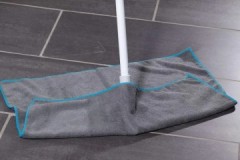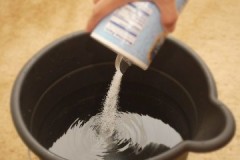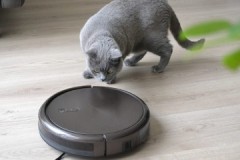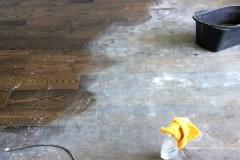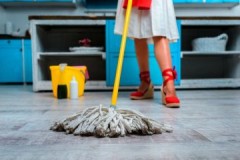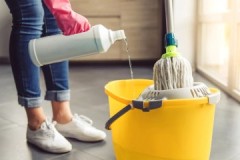 It would seem that it could be simpler - to wash the floor.But sometimes, after wet cleaning, stains remain on the floor covering, nullifying all the work done previously.
It would seem that it could be simpler - to wash the floor.But sometimes, after wet cleaning, stains remain on the floor covering, nullifying all the work done previously.
How to wash floors without streaks, for example, after renovation? Knowledge of the intricacies of the process, the ability to select the right detergent and equipment will help you clean the floor quickly and without streaks.
Content
Basic principles of washing
At first glance, the simple and familiar process of cleaning the floor is actually based on some rules that you can follow to achieve perfect cleaning results:
 Before wet cleaning begins, large debris, small-sized furniture (chairs, stools, ottomans), and toys are removed from the floor.
Before wet cleaning begins, large debris, small-sized furniture (chairs, stools, ottomans), and toys are removed from the floor.- Change the water as often as possible. Heavily contaminated areas are washed in advance.
- Large areas are washed zonally. The entire floor surface is conventionally divided into small sections, each of which is first wiped with a damp cloth, then with a dry one. This approach will help avoid divorces.
Cold water will help you forget about stains on freshly washed flooring forever.
The secret is simple: hot water evaporates as quickly as possible from the cold surface of the floor, leaving unattractive stains of detergents. Cold water evaporates very slowly, leaving time for the housewife to wash the floor without streaks.
Hands
High-quality hand washing of floors is carried out according to the following algorithm:
- The surface, previously cleared of large debris, is wiped with a soft cloth soaked in water and soapy water;
- Particularly contaminated areas are additionally treated with a cleaning agent and wiped with a soft sponge or brush;
- Wipe the linoleum again with a clean, well-wrung out cloth.
How to choose a rag?
A properly selected rag for washing is one of the important conditions for quick, high-quality cleaning without streaks.
An excellent option is viscose napkins.. Viscose does not leave streaks, absorbs water perfectly, and retains its shape for as long as possible even with everyday use.
Natural cotton fabrics (very often old bed linen and home textiles are used for cleaning) also absorb moisture well. But with frequent use, cotton rags very quickly begin to cough, leaving microscopic fluff on the freshly washed floor.
Acrylic is good for cleaning natural parquet. Soft acrylic perfectly polishes parquet, helping to maintain its radiant gloss and shine.
Microfiber cloths are good for cleaning heavily soiled floor surfaces. The special weave and texture help to quickly remove even very stubborn dirt and wash the floor without streaks.
Read about choosing a rag for cleaning the floor Here, about the best rags - Here.
Using a mop
High-quality wet cleaning using mops goes according to the following algorithm:
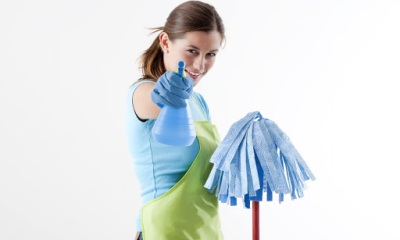 Wipe the floor around the perimeter of the room along the baseboard.
Wipe the floor around the perimeter of the room along the baseboard.- Using S-shaped movements, without lifting the mop from the surface, wipe the floor covering (it’s better to start from the corner, smoothly moving towards the door).
- As it gets dirty, rinse the rag from the mop in a bucket of water, wring it out and put it back on the mop.
After the floor is washed, open the windows in the room for ventilation. Once the flooring has dried, you can put the previously removed pieces of furniture back in their places.
Read about how often to wash floors here.
How to clean different types of surfaces?
Depending on the type of floor covering, not only the type of detergent is selected, but also the algorithm of action.
tiles
To restore shine to tiles, wash the floor carried out according to the following algorithm:
- Use a soft brush to remove large debris from the floor.
- Wipe the contaminated surface with a rag soaked in the prepared soap solution.
- Wash off the soap scum and wipe the tiles with a clean damp cloth.
- Rub the floor with a dry cloth or paper napkins.
- Advice: for washing glazed glossy tiles, it is better to select special products that contain mastic. Such products not only help to achieve the ideal result of wet cleaning without streaks, but also create a special film on the surface that facilitates the daily care of floor tiles.
Laminate
To clean laminate flooring without streaks, the process is carried out in the following sequence:
- use a soft brush, broom or vacuum cleaner to remove all large debris from the floor;
- wipe the prepared surface with a damp cloth (if necessary, add detergent to the water);
- The wet floor is wiped with a dry cloth.
How to properly clean laminate flooring at home, read this article.
Wood
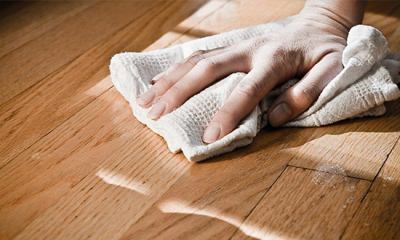 Wash painted wooden floors with a soft cloth or sponge soaked in water with the addition of baking soda (4 tbsp is enough for 2 liters of water).
Wash painted wooden floors with a soft cloth or sponge soaked in water with the addition of baking soda (4 tbsp is enough for 2 liters of water).
Do not use products containing chlorine on painted wood floors.. Otherwise, the tree acquires a whitish tint, which is impossible to get rid of.
Unpainted wooden floors are washed with a soft brush dipped in a soap solution (dissolve shavings of one bar of laundry soap in 5 liters of warm water).
Since an unpainted board is not protected by anything, it is very important to wipe the floor dry with a dry cloth immediately after wet cleaning (prolonged contact with water can cause deformation of the wooden board).
Linoleum
It is very easy to wash linoleum without streaks. Simply wipe the floor surface with a soft cloth dipped in soapy water.. Old, ingrained dirt is washed off in advance. After the floor is washed, wipe it dry again with a clean cloth.
Parquet
In order for parquet to please the eye with its shining gloss for as long as possible, it must be washed correctly. Firstly, parquet is washed only using special products. The second point that should not be forgotten is that parquet does not like moisture.
Stone, marble, granite
Natural stone floor surfaces are easy to care for. All you need to do is wipe the floor with a rag soaked in soapy water, then rinse off the remaining soap and wipe the surface dry with a dry rag.
Criteria for choosing a cleaning product
In order not to make a mistake and to choose the most suitable floor cleaning product from a wide range of stores, you need to be guided by several criteria:
- Compound. The most suitable option is a product with the maximum amount of natural ingredients in its composition. In the case where several products of different consistency are needed to clean the floor, it is better to give preference to products of the same brand and line (this way you can be sure that the combination of different compositions will not harm the floor covering).
- Purpose. When purchasing, you must carefully study the label to determine what type of flooring this or that product is intended for (as an option, the manufacturer often offers a universal cleaning solution).
Before purchasing, do not hesitate to open a bottle of detergent to evaluate the smell of the bottle's contents. A pronounced chemical, rich smell is a reason to refuse the purchase.
TOP 3 best
The following floor cleaning products deserve special attention:
BAGI ORANIT
The ideal detergent for streak-free floor cleaning. Suitable for all types of surfaces. Efficiently removes dust, grease, mold and mildew. The thick concentrate guarantees economical consumption.
The average cost is 350 rubles.
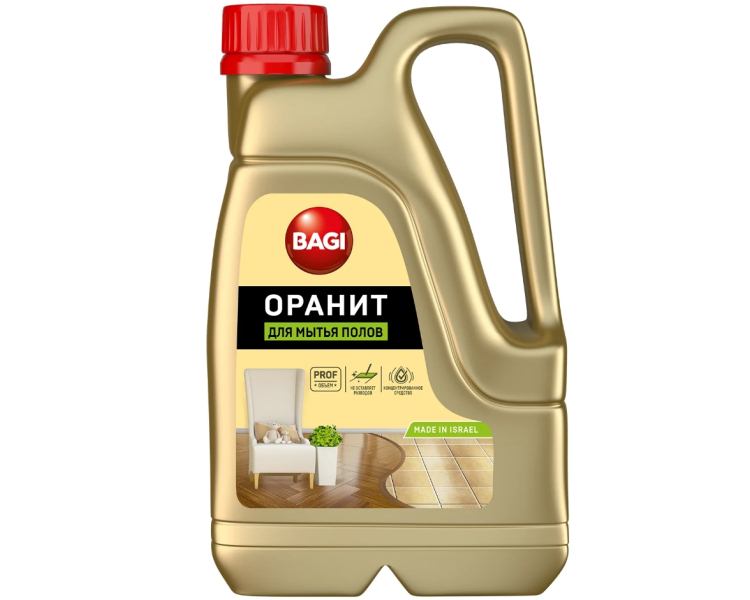
SANFOR 5 IN 1
Concentrated gel that helps get rid of complex stains on any type of floor surface. SANFOR also removes unpleasant odors, has antistatic and antimicrobial properties, and does not require rinsing.
The average cost is 150 rubles.

CHIRTON LIME AND MINT
Universal liquid floor cleaner. Designed for both everyday use and general cleaning. The product is biodegradable, has a very delicate subtle citrus aroma, and does not require rinsing with water.
The average cost is 100 rubles.
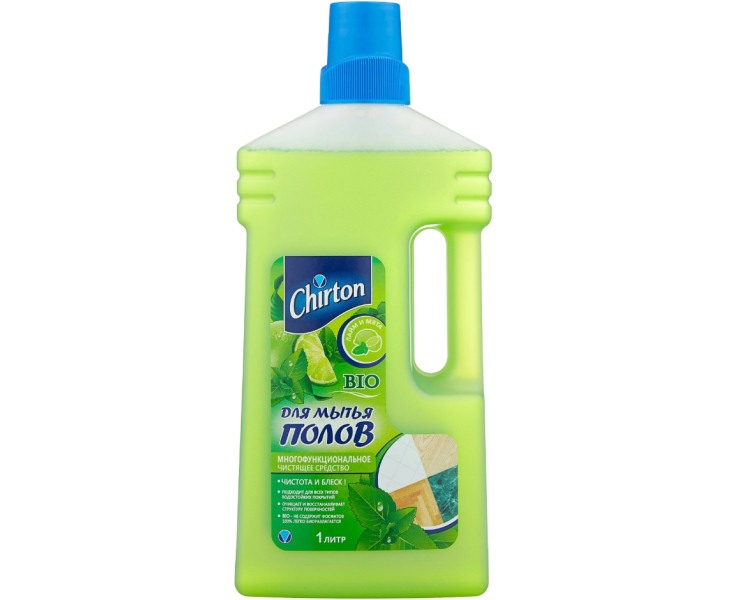
The rating of funds is presented Here, about household floor chemicals with a disinfectant effect - here, about anti-animal odor preparations - Here.
Traditional methods
There are many secrets known on how to clean the floor without streaks using improvised means:
- Vinegar water It will not only wash away dirt, but also disinfect floor surfaces and remove unpleasant odors. To prepare a cleaning solution, mix 2 tablespoons in five liters of water. vinegar.
- Salt - an excellent cleaning assistant, suitable for all types of surfaces (linoleum, laminate, tiles, painted floors). Salt is also considered an effective disinfectant (a good option for cleaning a house where small children live). To prepare a saline solution, you need to dissolve 5 tablespoons of salt in five liters of water (either regular table salt or sea salt). Once all the salt crystals have dissolved, you can start cleaning.
- Ammonia — an ammonia-based solution with a characteristic pungent odor will help clean dirty floor surfaces quickly and without streaks. Everything is very simple: the floor, previously cleaned of dust and debris, is wiped with a rag soaked in a solution of ammonia and water (1 tsp of ammonia is enough for 1 liter). It is important to ventilate the room very well after cleaning so that ammonia vapors do not affect the well-being of household members.
- White Well suited for cleaning floors in houses where animals live. Whiteness not only leaves no streaks, but also perfectly disinfects surfaces, eliminates unpleasant odors, fungi and mold.In order to achieve high quality cleaning, it is important to prepare the correct solution.
To do this, dilute 100 ml of White in 1 liter of water (if small children live in the house, 50 ml is enough). Use a rag soaked in the resulting solution to wipe the floor covering, which has previously been cleared of large debris, and then allow it to dry naturally.
Read about bleach for cleaning floors in this article.
Cleaning up after renovation
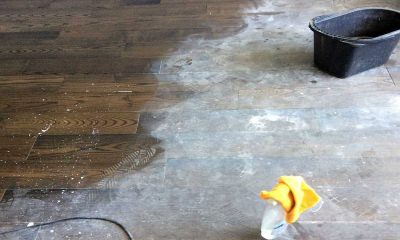 Unlike everyday wet cleaning, cleaning the floor after renovation requires more time and, importantly, knowledge of the intricacies of the process.
Unlike everyday wet cleaning, cleaning the floor after renovation requires more time and, importantly, knowledge of the intricacies of the process.
The main problem that you will have to face is a large amount of fine construction dust.
To remove it, it is better to abandon the vacuum cleaner (there are high risks of failure of household appliances), and use proven equipment - a broom dipped in warm water.
After large debris and dust have disappeared from the floor, you can proceed to the next stage - removing stains of putty, whitewash and traces of other building materials.
Warm water with the addition of vinegar will help to quickly clean traces of whitewash (100 ml of vinegar is enough for 5 liters of water) so that not a trace remains of whitish stains on the floor.
The pharmaceutical product Dimexide can remove the remains of polyurethane foam.. It is applied to the stain, left for three minutes, after which the softened traces of foam are carefully removed with a construction spatula.
To remove dried traces of paint, simply wipe them with a cotton sponge soaked in white spirit. And finally, wipe the floor with a rag soaked in water with the addition of vegetable oil (add 1 tsp of oil per liter of water).This procedure will help restore the shine and shine to the floor covering.
Before using aggressive solvents and other chemicals, they must be tested on a small, inconspicuous area of the floor covering.
Even more information - here.
Useful tips
Treating linoleum with mastic will greatly facilitate the daily care of the floor covering.. It is enough to dilute two tablespoons of liquid mastic in two liters of warm water and apply the resulting solution with a sponge to clean linoleum.
The resulting film will not only protect against rapid contamination, but will also help maintain the gloss of the floor covering.
Polish will help preserve the gloss of natural parquet, prepared at home from scrap materials (mix 5 liters of water, 6 tablespoons of vinegar and 4 tablespoons of furniture polish in a clean container). The mixture that is not used after cleaning is stored in a warm, dry place in a hermetically sealed jar or bottle.
Citric acid will help make tiles shine. To do this, dissolve 1 tbsp in five liters of water. l of dry powder, then wipe the floor with a rag soaked in the resulting product.
Conclusion
A properly selected detergent and strict adherence to the sequence of actions will help you clean the floor quickly and without streaks.
